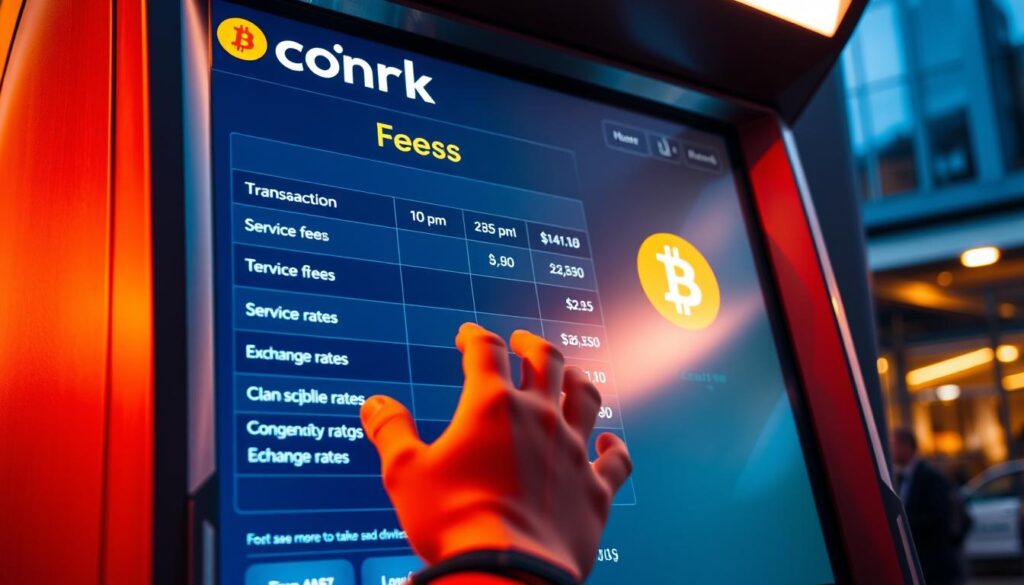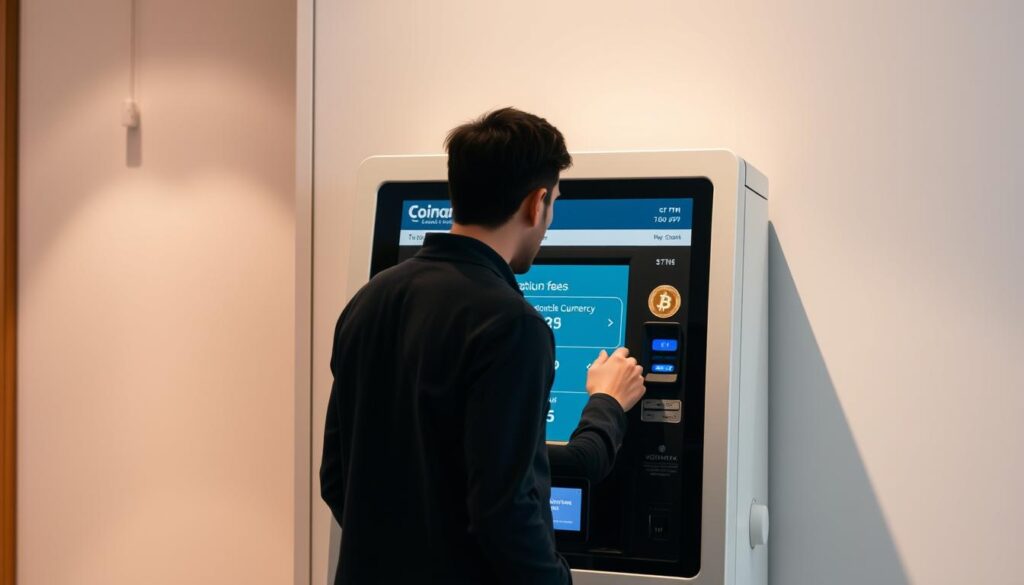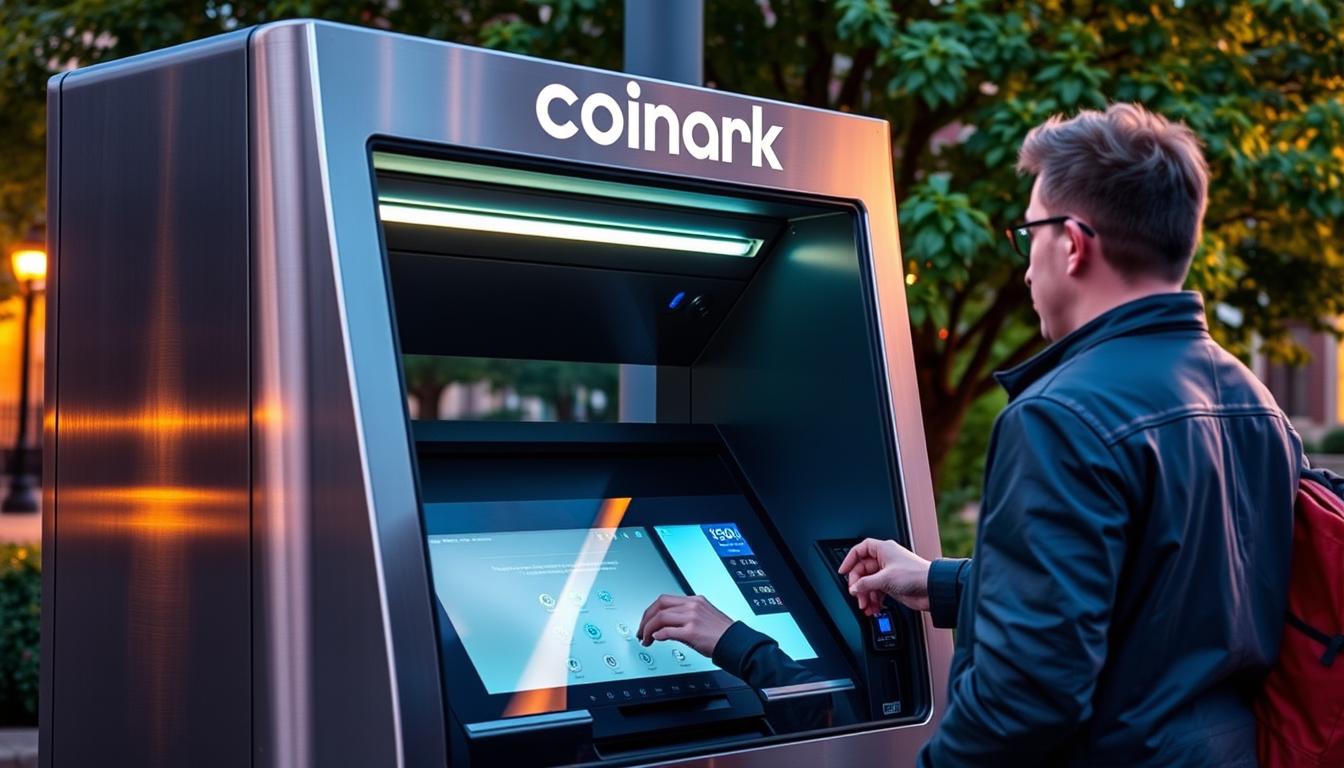Ever wondered why transaction costs vary so much when using digital currency services? Whether you’re new to crypto or a seasoned user, understanding the true cost of each exchange matters. In Meadville, PA, we make it simple with transparent pricing at our Coinark location.
Nationally, service charges range between 5% and 25%, plus small network costs. At 560 Washington St, we offer competitive rates to help you maximize value. This guide breaks down what to expect—so you stay informed and in control.
With digital transactions growing across Pennsylvania, knowing how fees work saves money. We’ll compare local options and share tips to reduce expenses. Plus, registered users enjoy higher limits for seamless transactions.
Key Takeaways
- National averages include a 8%-24% service charge plus minor network costs.
- Coinark provides a local solution at 560 Washington St with clear pricing.
- Understanding fee structures helps avoid unnecessary expenses.
- Registered users benefit from daily limits up to $25,000.
- Practical tips can lower your overall transaction costs.
Introduction to Bitcoin ATMs and Their Fees
With over 40,000 machines worldwide, crypto ATMs bridge the gap between digital and cash. These kiosks let you buy or sell digital assets instantly—no waiting for bank transfers or exchange approvals.
How do they work? Unlike online exchanges that take days, ATMs complete transactions in minutes. Some machines only allow purchases, while others support both buying and selling (two-way functionality).
Typical limits range up to $5,000 daily, depending on the operator. You’ll need a wallet app, phone, and ID for larger transactions. Here’s a quick comparison:
| Type | Speed | Functionality |
|---|---|---|
| One-Way | Instant | Buy only |
| Two-Way | Instant | Buy & sell |
In Pennsylvania, installations are growing as crypto adoption rises. Machines operate 24/7, offering unmatched convenience. Leaders like Coinstar and Coinme dominate the market.
Fees include a transaction charge (set by the operator) and network costs (paid to miners). We’ll explore these in detail next, using real examples from our Meadville location.
Understanding Bitcoin ATM Fees Explained Meadville, PA
Navigating digital currency costs starts with understanding service charges. Whether you’re buying or selling, fees ensure smooth operations. Let’s explore what goes into these costs and how they impact your transactions.
What Makes Up the Total Cost?
Every exchange includes two main components: a service charge (set by operators) and network costs (paid to miners). For example, a 15% base fee + $3 network fee is common. Here’s how they differ:
| Fee Type | Purpose | Who Receives It? |
|---|---|---|
| Service Charge | Covers compliance, maintenance, and support | Operators |
| Network Fee | Processes transactions on the blockchain | Miners |
Why Operators Charge Fees
Providers balance convenience with expenses. Running a secure, compliant service isn’t cheap. Key costs include:
- Licensing: Over $10k/month for KYC/AML compliance.
- Cash logistics: Replenishing machines in rural areas costs more.
- 24/7 support: Teams handle queries and troubleshoot issues.
Urban locations often have lower fees due to higher traffic. Rural spots may charge slightly more for accessibility. Pre-registration, like CoinTime’s 30% discount, can reduce costs.
Pennsylvania mandates fee transparency, so you’ll always see the total before confirming. Unlike some online platforms, there are no hidden surprises.
Coinark Bitcoin ATM: Location and Overview
Finding a reliable digital currency kiosk starts with knowing where to look. Our 560 Washington St spot in Meadville offers *hassle-free* transactions with clear pricing. The bright-blue machine stands near local shops, open 24/7 for urgent trades.
This two-way kiosk supports buying and selling, with limits up to $50,000 for verified users. Cameras and LED lighting ensure safety, while ADA-compliant design welcomes all visitors. Free parking and bus stops nearby simplify access.
How does it compare? Within 5 miles, competitors average 12–20% fees—ours are lower. Registering unlocks perks like faster verification and higher limits. Check real-time availability via our interactive map before visiting.
Coinark is part of CoinTime’s 170+ global network, blending local service with international reach. Whether you’re cashing out or investing, our Washington St location delivers speed and transparency.
Types of Bitcoin ATM Fees You Might Encounter
Not all digital currency costs are created equal—some fees hit harder than others. Whether you’re buying or selling, knowing what to expect helps you avoid surprises. Let’s break down the three main categories.

Transaction Fees
Operators charge these to cover compliance, maintenance, and support. Nationally, they average 23%, but in Pennsylvania, rates range from 15% to 25%. For example, CoinFlip charges 24%, while competitors like Bitcoin Depot may hit 20%.
Dynamic pricing during market volatility can spike costs temporarily. Always check the final total before confirming.
Network Fees
These go to miners processing blockchain transactions. The average is $1.23, but congestion can push it higher. Think of it like rush-hour tolls—timing matters.
Some operators absorb this cost, while others pass it to you. Coinark’s transparent pricing shows both fees upfront.
Hidden Fees to Watch Out For
Sneaky charges lurk in markups or add-ons. Common ones include:
- Exchange rate markups (3%–5% industry standard)
- SMS verification fees ($0.50–$2 per text)
- Receipt printing costs ($1–$3)
Pennsylvania’s 2024 regulations require full disclosure but always audit your receipt. Coinark’s no-surprise guarantee ensures you pay only what’s shown.
How Bitcoin ATM Fees Compare to Online Exchanges
Online platforms and physical kiosks offer different trade-offs for crypto users. While exchanges like Coinbase charge 0.5%–4.5%, ATMs average 15%. But speed and accessibility often justify the cost.
| Service | Avg. Fee | Speed | KYC |
|---|---|---|---|
| Coinark ATM | 15% | Instant | Phone ID |
| Coinbase | 1.5% | 3–5 days | Full ID |
Exchanges win on fees but lose on speed. ACH transfers take 7–10 days, while ATMs deliver funds in minutes. For urgent needs, the premium makes sense.
Unbanked users benefit most—cash transactions skip bank delays. ATMs also simplify buying Bitcoin steps: scan a wallet QR code, insert cash, and confirm.
Tax reporting applies to both, but exchanges provide detailed records. ATMs require manual tracking. For a $500 purchase:
- ATM: ~$75 fee, instant.
- Exchange: ~$7.50 fee, 3-day wait.
Choose based on urgency. Need crypto today? ATMs bridge the gap. Planning ahead? Exchanges save money.
Top Bitcoin ATM Operators and Their Fee Structures
Different operators offer unique pricing models for digital currency transactions. Whether you’re a frequent trader or a first-time user, knowing who charges what helps you save. Let’s explore how major providers stack up.
Coinark’s Straightforward Pricing
Our 15% flat fee plus network costs keeps pricing simple. No hidden markups or surprise charges—just transparent rates. Verified users enjoy bulk discounts, like 10% off transactions over $1,000.
We also prioritize compliance, holding full MSB licenses for secure operations. Emergency support responds in under 15 minutes, day or night.
How Other Providers Compare
National chains like CoinFlip (10%–24%) and RockItCoin ($1 + 18.7%) offer competitive rates but lack regional flexibility. Athena charges 10%–25%, with higher fees in rural areas.
Key differences include:
- Loyalty programs: Coinark rewards repeat users; RockItCoin offers tiered perks.
- Sell functionality: 80% of our kiosks support two-way transactions.
- Mobile integration: Our app tracks real-time rates and nearby kiosks.
For urgent needs, operators with 24/7 access and cash deposits often outperform card-only services. Always check local options—our interactive map highlights the closest low-fee kiosks.
Factors That Influence Bitcoin ATM Fees
Digital currency exchange costs aren’t random—multiple factors shape what you pay. From where you transact to real-time market swings, understanding these variables helps you save.
Why Your Location Matters
Urban machines often charge 19% versus 15% in rural areas like Pennsylvania. High rent and security costs in cities drive this gap. Operators also adjust rates based on:
- Competitor proximity: More nearby kiosks mean lower fees
- Cash logistics: Remote locations incur higher replenishment costs
- Local regulations: PA’s 2024 tax updates may affect pricing
Weekend and holiday premiums exist too. Evening transactions (after 8 PM) sometimes carry 3% surcharges due to staffing costs.
How Market Swings Affect Pricing
When values fluctuate over 10%, many operators add 5% volatility buffers. This protects against sudden price drops during processing. Other market-sensitive factors include:
“Liquidity providers adjust rates hourly—busy trading periods often mean higher network costs.”
Special events like crypto conferences can temporarily spike demand. Weather disruptions may also delay cash deliveries, creating short-term fee adjustments.
We monitor these changes closely at our Washington St location. Our dynamic pricing model ensures fairness while keeping services reliable.
How to Calculate Bitcoin ATM Fees
Crunching the numbers on digital currency exchanges doesn’t have to be confusing. We’ll walk you through the math so you know exactly what to expect. Let’s start with a real-world example.

The Simple Formula
Every transaction follows this rule: (Amount × Percentage Fee) + Fixed Network Fee. For a $500 purchase at 15%:
- Service charge: $500 × 0.175 = $87.50
- Network fee: $2 (average)
- Total cost: $89.50
Here’s how different models compare:
| Fee Type | Example | Total Cost |
|---|---|---|
| Percentage | 15% of $500 | $87.50 + $2 |
| Flat Rate | $10 flat + $2 | $12 |
Percentage fees scale with your amount, while flat rates suit smaller transactions. Our CoinTime calculator tool automates this math—just plug in your numbers.
Reading Your Receipt
Always check the breakdown before confirming. Look for:
- Pre-fee crypto amount (e.g., 0.012 BTC)
- Post-fee total (e.g., 0.01 BTC)
- Network cost (listed separately)
Common pitfalls include missing exchange rate markups or SMS verification charges. Pennsylvania law requires full disclosure but double-checking saves surprises.
“Save receipts for tax purposes—the IRS treats crypto like property. Fees may be deductible as transaction costs.”
We offer a free spreadsheet template to track audits. Just ask our team at the kiosk or download it online.
Tips to Minimize Bitcoin ATM Fees
Smart strategies can help you keep more of your money when exchanging digital assets. Whether you’re a frequent trader or a first-time user, these practical tips reduce costs without sacrificing convenience.
Pick the Right Service
Not all kiosks charge the same rates. Compare nearby operators to find the best deal. For example, pre-registering with CoinTime slashes costs by 30% instantly.
Batch transactions also help. Group smaller trades into one to avoid repeated service charges. Loyalty programs add extra perks—sign up for bonuses like fee waivers.
Time It Right
Network congestion affects prices. Aim for off-peak hours like Tuesdays 10 AM–2 PM when miner fees drop. Avoid weekends or holidays when surcharges spike.
Monitor exchange trends too. Rates dip during low-volatility periods. Tools like CoinGecko’s congestion tracker provide real-time updates.
“Bulk purchases over $1,000 often qualify for negotiated discounts—always ask before confirming.”
Finally, audit receipts for errors. Disputes can recover overcharges. With these steps, you’ll maximize value on every trade.
Security and Safety Tips for Using Bitcoin ATMs
Keeping your digital assets safe starts with smart habits. While fraud rates remain low at 0.3% nationally, vigilance protects your money and personal data. Follow these proven strategies to secure every transaction.
Wallet security comes first. Always use a trusted app with two-factor authentication. Never share your private keys—legitimate services won’t ask for them. Here’s how to spot risks:
| Threat | Prevention Tip |
|---|---|
| ATM skimmers | Check for loose card readers or hidden cameras |
| Phishing scams | Verify SMS codes directly with the provider |
| Address spoofing | Double-check wallet QR codes before scanning |
Surveillance matters too. Choose well-lit locations with visible cameras. Our Washington St kiosk features 24/7 recording and emergency buttons. Pennsylvania law requires these protections.
After completing your process, destroy paper receipts properly. They contain sensitive data criminals could exploit. For extra security:
- Enable dark web monitoring alerts
- Freeze transactions if your phone is lost
- Update wallet software monthly
“97% of machines now require SMS verification—a simple step that prevents 80% of fraud attempts.”
Remember these red flags: unsolicited help offers, mismatched exchange rates, or pressure to act quickly. Trust your instincts—if something feels wrong, cancel the transaction.
We prioritize your safety through encrypted connections and regular machine inspections. Our team trains monthly on the latest security protocols to keep your assets protected.
Step-by-Step Guide to Using Coinark Bitcoin ATM
Exchanging digital currency at a kiosk is easier than you think—here’s how. Our Washington St location in Meadville offers a seamless process with clear instructions. Whether buying or selling, follow these steps for a smooth transaction.
Buying Bitcoin at Coinark
Start by scanning your wallet QR code at the machine. The bright-blue kiosk accepts bills from $5 to $100. Here’s the full process:
- Insert cash: The bill validator confirms amounts instantly.
- Verify ID: For transactions over $900, scan your phone number for SMS confirmation.
- Confirm details: Check the exchange rate and fees before finalizing.
Transactions complete in under 2 minutes. Need help? Press the VIP concierge button for live support.
Selling Bitcoin at Coinark
Selling works similarly but requires a few extra steps:
- Select “Sell” on the screen and enter your amount.
- Send crypto to the displayed address (double-check for accuracy).
- Collect cash from the dispenser—receipts include a backup QR code.
Daily limits cap at $5,000 for unverified users. Registered accounts unlock higher thresholds.
“Always review the cancelation policy—you have 30 seconds to abort if errors occur.”
For errors like stuck bills or network delays, our troubleshooting guide appears on-screen. Visit 560 Washington St anytime—we’re open 24/7.
Conclusion
Making informed choices about digital transactions saves time and money. At our Washington St location, we combine competitive rates with 24/7 access—so you always get fair value.
Recap key takeaways: Meadville users enjoy lower-than-average fees, and registered accounts unlock higher limits. Our free consultations help you plan exchanges wisely.
Looking ahead, 2024 trends show tighter regulations but better transparency. We’ll keep adapting to serve you best. Need help? Visit our kiosk or call support anytime.
Thank you for trusting us with your bitcoin atm needs. Together, we’re building a smarter crypto community—one transaction at a time.

